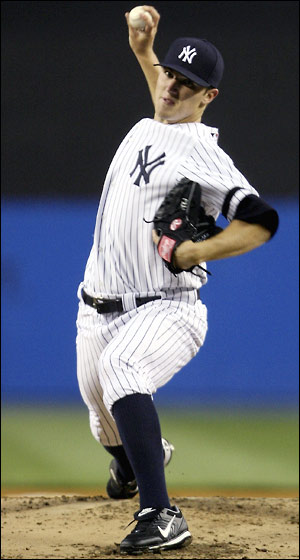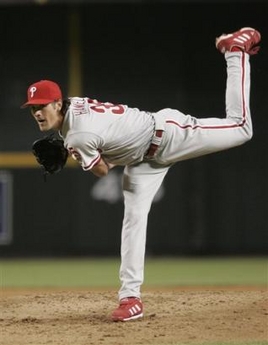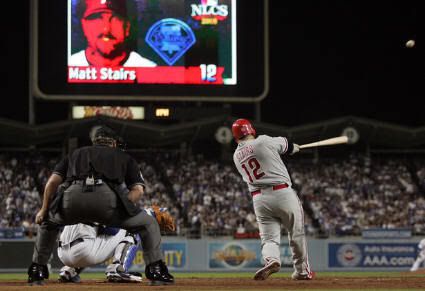The Good News: Phil Hughes pitched well last night against the Tigers. He used 99 pitches to shut them out for six innings, allowing only two hits and two walks while fanning six.
The Bad News: People are starting to talk about putting Joba Chamberlain back in the bullpen.
The New York Daily News' John Harper makes some good points, but may be reaching a bit here:
For now, at least, they seem firmly committed to keeping Chamberlain in the rotation. But part of the equation here is that he shows no signs of being a dominating starter.Well, he was pretty dominant against the Royals two weeks ago, but admittedly he had a tough time with Cleveland and Boston, two of the better offensive teams in baseball. It seems to me that three starts are not much of a barometer for whether he's going to be dominant.
For example, Mike Pelfrey and Scott Baker are both young pitchers, struggling more than Joba in their three 2009 starts. But they both pitched well in 2008, and nobody is talking about replacing Pelfrey's starts in the Twins' or the New York Mets schedule. Admittedly, neither of their teams has the potential glut of capable starting pitching the Yankees seem to have, but still, the analogy is worth considering.
One of the reasons Harper suggests changing Joba's role is that he would be able to throw harder and emote more freely in short stints out of the bullpen, rather than having to pace himself as a starter does, and therefore be more effective.
Well, not quite that high, and not all the time, but sure, let's say he's right about Beckett. So what?Since spring training the fastball velocity has been an issue, as he throws mostly around 92-93 mph now as opposed to 96-97 when he was relieving.
And while his celebrations as a reliever may have been a bit over the top, he seemed fueled by the emotion and let-it-go fire he could pour into a one-inning stint, as opposed to pacing himself as a starter.
The combination of lower velocity and a mostly placid demeanor have baseball people wondering what's wrong with Joba.
"There shouldn't be that kind of difference in velocity between starting and relieving," one AL scout said Monday. "When (Josh) Beckett is right, he's topping out at 96-97 from start to finish.
Beckett has made exactly three regular season relief appearances in his major league career, and those were six and seven years ago. We have no way to compare whether the 4-5 mph drop from starting to relieving is appropriate or normal, at least not from Beckett. Maybe Beckett would be able to throw 102 mph if he only had to pitch one inning a night. Maybe 96 mph IS "pacing himself" in Beckett's case, a scary thought indeed.
One of the few examples we can use of a starting pitcher being used for short stints is at the All Star game. Though they usually work at more modest velocities, pitchers who know they'll only be throwing one inning tend to dial it up a bit more when they get called in to pitch. Brad Penny, who typically works in the 90-91 mph range, threw 95-96 mph when he started the 2006 All Star game, knowing that he wouldn't go more than two innings.
The fact of the matter is that anybody with any sense who discussed this issue last year knew that Joba would likely not throw as hard as a starter, would not dominate the way he did out of the pen in 2007-08. Nobody compiles a 1.53 ERA and strikes out almost 12 batters per game as a starter, at least not for very long, not in this era. If you were expecting that, you were mistaken.

But Joba can still be a good or even great starter, given the chance, without registering a "99" on the stadium gun every time he releases the pill. And perhaps if Pettitte and Sabathia and Burnett and Hughes and Wang are all pitching well, and taking up every start in the New York Yankees schedule, Joba would be the logical choice to relieve. But at this point Wang is a question mark at best, and Hughes has made exactly one good start.
One.
Why would it be so bad to put Joba back in the bullpen?
Rob Neyer answers that question:
I've always come down squarely on the side of Chamberlain starting, for the simple reason that a good starting pitcher is more valuable than a great relief pitcher. Or rather, that a great starting pitcher is more valuable than a great reliever, and there were (and still are, presumably) some observers who believe that Chamberlain can become a great starter.Chamberlain doesn't even need to become a great starter, though obviously that is still the hope. Neyer said it right the first time: A good starter is more valuable than a great reliever.
Last year, Jamie Moyer and Gil Meche and Kyle Lohse and Paul Maholm were all good, but not great starters. Each pitched around 200 innings with an ERA just under 4.00. Each had a VORP of about 40 (i.e. they were worth about 40 runs more than a replacement level starting pitcher over the same number of innings.)
By comparison, the best relievers (Scott Downs, the Mexicutioner, Brad Ziegler, Joe Nathan) were all around 30. Mariano Rivera was almost 35, but he's the exception to several rules, the one about the value of relief pitchers notwithstanding. So if Joba is healthy enough to pitch close to 200 innings, and good enough to compile an ERA under 4.00, he'll be worth about ten runs more than he would if he were to pitch only 70 innings with an ERA around 2.00. Got it?
Ten runs isn't an enormous amount, but it's probably about one win, and in what is shaping up to be a tightly contested AL East, one win might make all the difference. But, as Billy Mays says, wait, there's more.
You see, 70 innings with a 2.00-ish ERA is about the maximum that we can hope for from Joba as a reliever. Sure, he could post a 1.50 ERA. He could pitch 80 or 90 innings. But the Yankees would either have to use him more often or for longer stints, and given their history of handling the kid with, well, kid gloves, that's not likely.
As a starter, however, Joba could still thrive. It will be enough if he gives us 180 innings with a 3.75 ERA, but he could still find a groove and rack up 210 innings with a 2.99 ERA (his career mark as a starter) which would make him,
A) Worth about 60 VORP, i.e. twice as valuable as a very good reliever, and
2) One of the best starters in MLB.
Putting him back in the bullpen effectively eliminates this possibility.
Are we really ready to throw Joba's career under the bus after three starts in April? Give the man a chance to build up some stamina. Give him a chance to prove himself against some other teams. Give him a chance to throw more than 93 pitches.
He doesn't have to be great to be worthwhile as a starter. He just has to be good.
But he still might be great. Don't take that away from us.




























